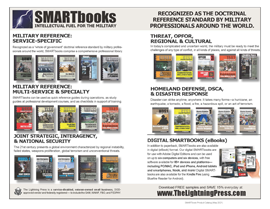Related Books
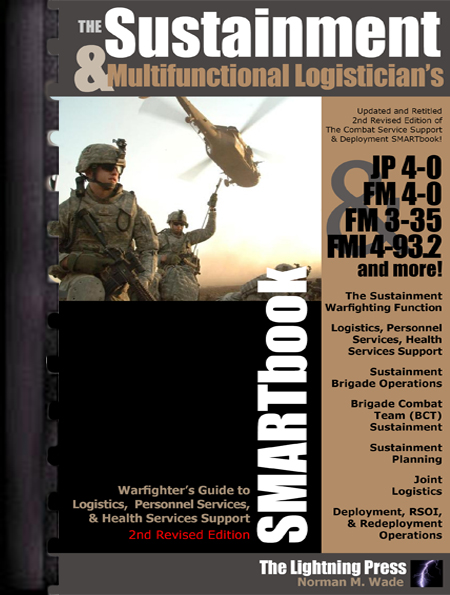
The Sustainment & Multifunctional Logistician’s SMARTbook, 2nd. Rev. Ed. (PREVIOUS EDITION)
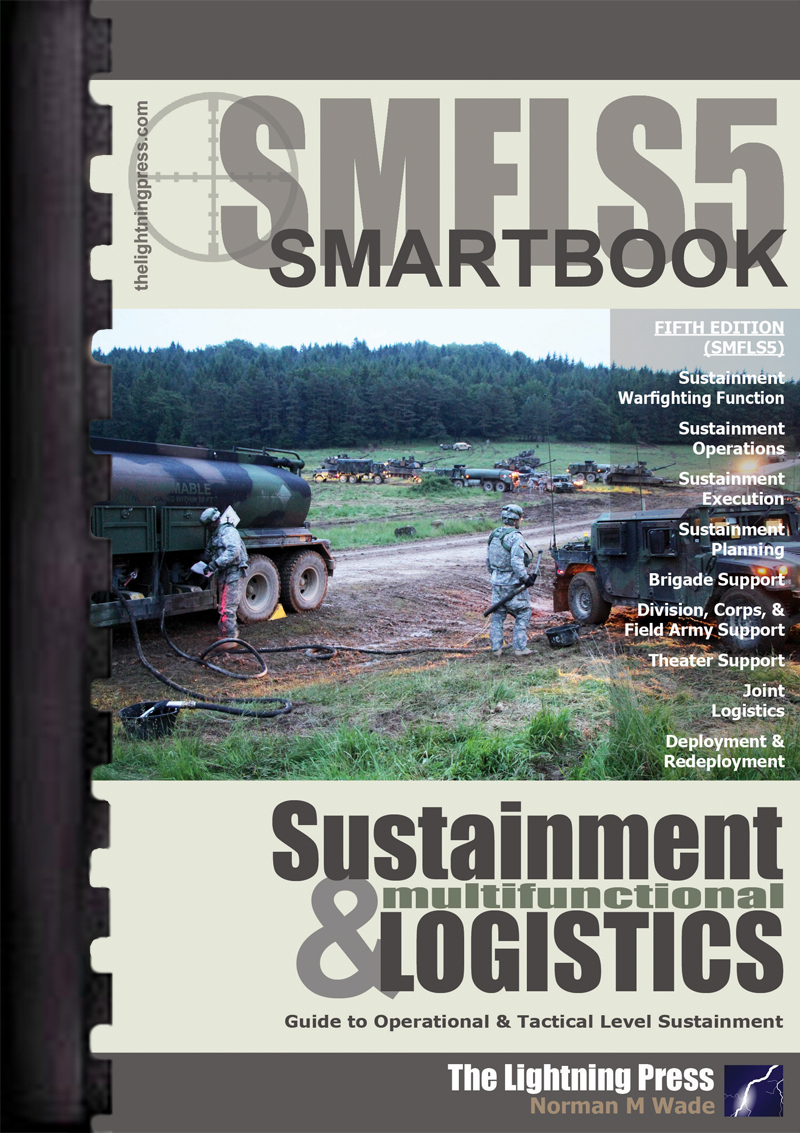
SMFLS5: The Sustainment & Multifunctional Logistics SMARTbook, 5th Ed.

BSS7: The Battle Staff SMARTbook, 7th Ed.
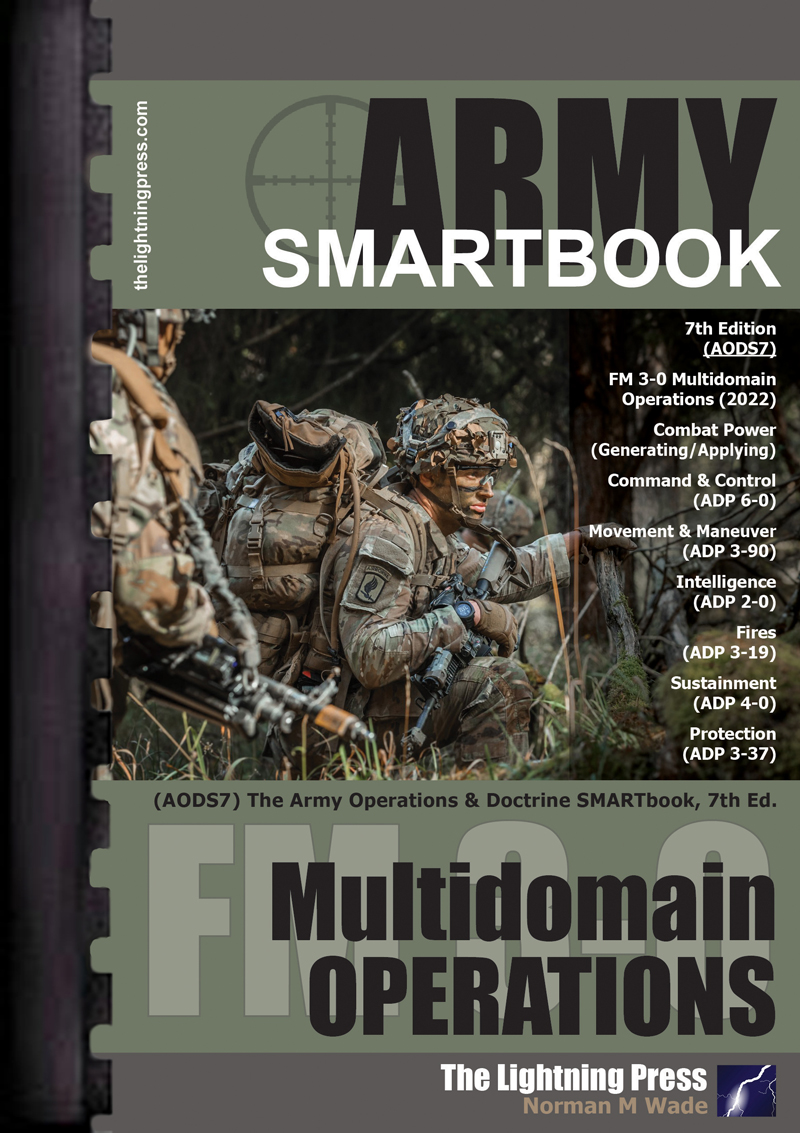
AODS7: The Army Operations & Doctrine SMARTbook, 7th Ed.
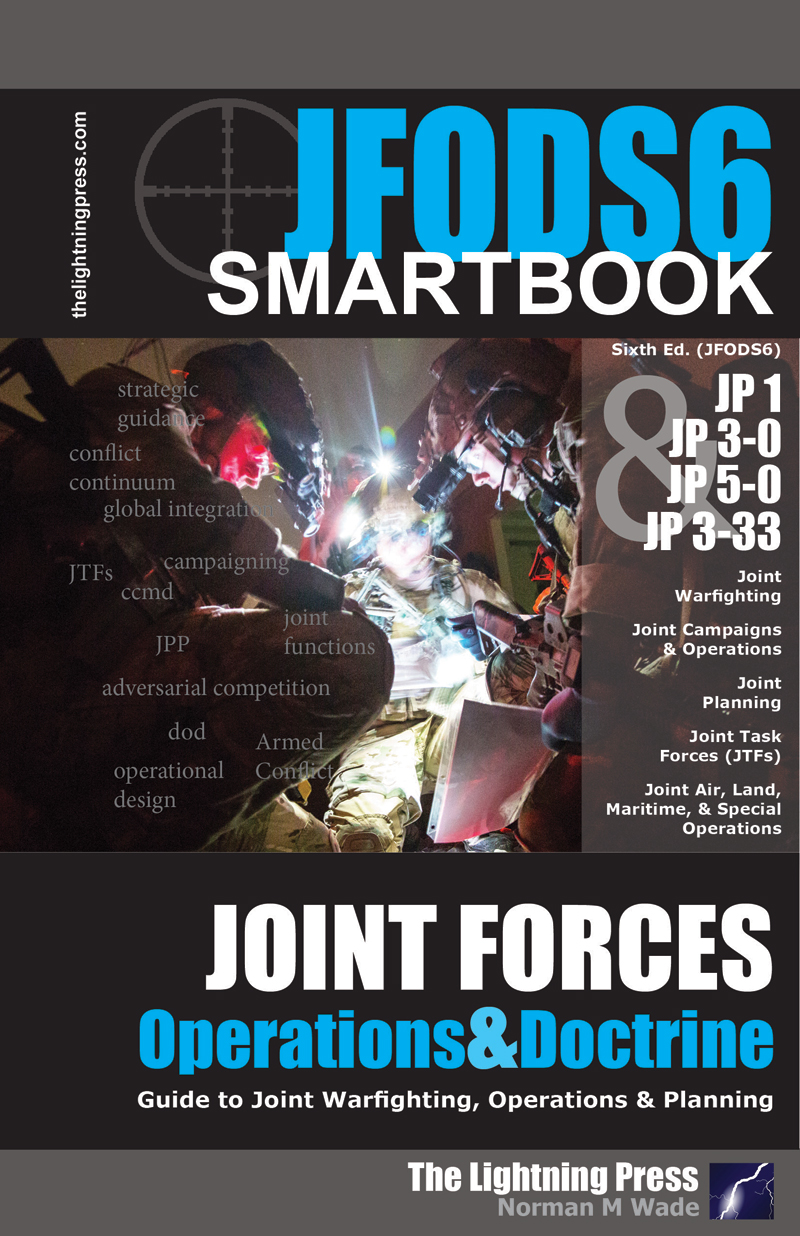
JFODS6: The Joint Forces Operations & Doctrine SMARTbook, 6th Ed.
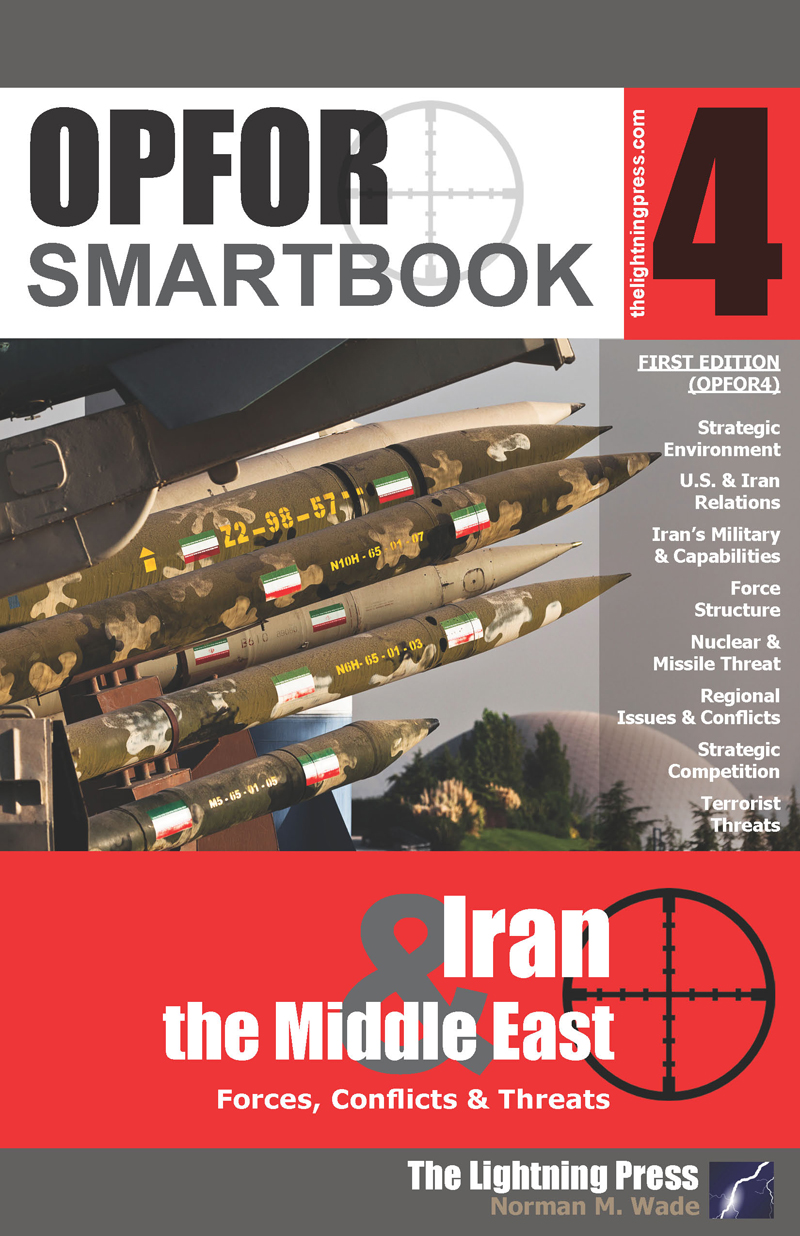
OPFOR SMARTbook 4 - Iran & the Middle East
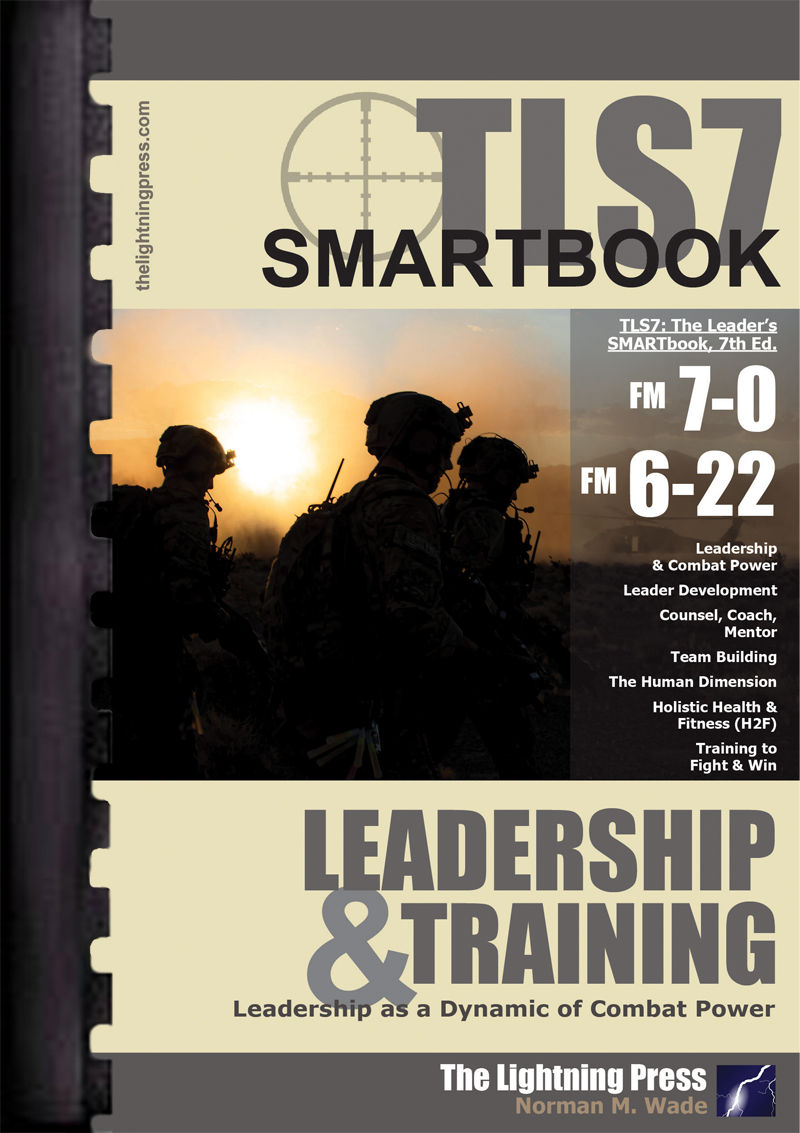
TLS7: The Leader’s SMARTbook, 7th Ed.
The Sustainment & Multifunctional Logistician’s SMARTbook, 2nd. Rev. Ed. (PREVIOUS EDITION)

Release Date :Oct 1st, 2009
Norman M. Wade
Binding Type:Plastic Comb
Print Inside Pages:Black and White
Trim Size:5.5'' x 8.5''
Total Pages:320

A NEW edition of this book is available!
SMFLS5: The Sustainment & Multifunctional Logistics SMARTbook, 5th Ed.
Upgrade/update to the NEW 5th Edition (SMFLS5)!
Upgrade/update to the NEW edition!The Sustainment & Multifunctional Logistician’s SMARTbook, 2nd Rev. Ed. (Oct 2009) has been superseded by a newer 4th edition SMFLS4 (Dec 2015). Always check our website for the most current and up-to-date SMARTbook edition! The Lightning Press is committed to providing the best and most relevant doctrinal material to our readers and are vigilant in reviewing new publications, anticipating upcoming doctrinal releases, and incorporating the updated material into our SMARTbook series! Click "View New Edition" above to browse the new edition! SMFLS4 is the fourth revised edition of The Sustainment & Multifunctional Logistics SMARTbook. In addition to the most current versions of ADP/ADRP 4-0 Sustainment (Jul ‘12), SMFLS4 incorporates the full scope of new material from ATP 4-94 Theater Sustainment Command (Jun ‘13), ATP 4-93 Sustainment Brigade (Aug ‘13), ATP 4-90 Brigade Support Battalion (Aug ‘14), Sustainment Planning, JP 4-0 Joint Logistics (Oct ‘13), ATP 3-35 Army Deployment and Redeployment (Mar ‘15), and more than a dozen new/updated Army sustainment references to include ATP 4-33, ATP 4-42, ATP 4-16, ATP 4-0.1, ATP 4-34.40, ATP 4-92, FM 1-0, FM 1-04, FM 1-05, FM 1-06, FM 4-01, FM 4-02, and FM 4-30!Related Books
SMFLS5: The Sustainment & Multifunctional Logistics SMARTbook, 5th Ed.
ISBN-10 :193588686X
Release Date :May 4th, 2021
Norman M. Wade
Binding Type:Plastic Comb
Print Inside Pages:Black and White
Trim Size:5.5'' x 8.5''
Total Pages:368

Paperback Edition
Price: $42.95 $36.95

Bundle & Save (Paperback + Digital)
Price: $85.90 $49.95
Guide to Operational & Tactical Level Sustainment
SMFLS5:The Sustainment & Multifunctional Logistics SMARTbook, 5th Ed. has been completely updated for 2021. At 368 pages, SMFLS5 topics and references include the sustainment warfighting function (ADP 4-0); sustainment operations (FM 4-0), sustainment execution (logistics, financial management, personnel services, & health services support); sustainment planning; brigade support (ATP 4-90, Brigade Support Bn); division, corps & field army sustainment (ATP 4-93, Sustainment Brigade); theater support (ATP 4-94, Theater Support Command); joint logistics (JP 4-0); deployment & redeployment (ATP/JP 3-35); and more than a dozen additional new/updated Army sustainment references.
The sustainment warfighting function is the related tasks and systems that provide support and services to ensure freedom of action, extended operational reach, and prolong endurance. Sustainment determines the depth and duration of Army operations. Successful sustainment enables freedom of action by increasing the number of options available to the commander. Sustainment is essential for retaining and exploiting the initiative. The sustainment warfighting function consists of four elements: logistics, financial management, personnel services and health service support.
Sustainment is essential for conducting operations and generating combat power as the Army performs its strategic roles. Sustainment provides the operational commander freedom of action, operational reach, and prolonged endurance necessary to shape operational environments, prevent conflict, prevail in large-scale ground combat operations, and consolidate gains.
The effectiveness of the sustainment warfighting function is dependent upon actions of units and staffs at the operational and tactical levels. Execution is putting a plan into action by applying combat power to accomplish the mission. It focuses on actions to seize, retain, and exploit the initiative. Sustainment determines the depth and duration of Army operations. It is essential to retaining and exploiting the initiative and it provides the support necessary to maintain operations until mission accomplishment. Failure to provide sustainment could cause a pause or culmination of an operation resulting in the loss of the initiative.
Related Books
Discount sets with this book
BSS7: The Battle Staff SMARTbook, 7th Ed.
ISBN-10 :1-935886-94-0
Release Date :Oct 1st, 2023
Norman M. Wade
Binding Type:Plastic Comb
Print Inside Pages:Black and White
Trim Size:5.5'' x 8.5''
Total Pages:360

Paperback Edition
Price: $42.95 $36.95

Bundle & Save (Paperback + Digital)
Price: $85.90 $49.95
Planning & Conducting Multidomain Operations
BSS7: The Battle Staff SMARTbook, 7th Ed. is completely updated for 2023 to include FM 5-0 w/C1, Planning and Orders Production (2022); FM 6-0, Commander and Staff Organization and Operations (2022), FMs 1-02.1/.2, Military Terms & Symbols (2022); and more!
Focusing on planning and conducting multidomain operations (FM 3-0 Operations, 2022), BSS7 covers the operations process; commander and staff activities; the five Army planning methodologies - Army Design Methodology (ADM), Military Decison-making Process (MDMP), Troop Leading Procedures (TLP), Rapid Decision-Making and Synchronization Process (RDSP), & Army Problem Solving; integrating processes (IPB, information collection, targeting, risk management, and knowledge management); plans and orders; mission command, C2 warfighting function tasks, command posts, liaison; rehearsals & after action reviews; and operational terms and military symbols.
The Army’s framework for organizing and putting command and control into action is the operations process—the major command and control activities performed during operations: planning, preparing, executing, and continuously assessing the operation. Commanders use the operations process to drive the conceptual and detailed planning necessary to understand their operational environment (OE); visualize and describe the operation’s end state and operational approach; make and articulate decisions; and direct, lead, and assess operations.
Commanders, staffs, and subordinate headquarters employ the operations process to organize efforts, integrate the warfighting functions across multiple domains, and synchronize forces to accomplish missions. This includes integrating numerous processes and activities within the headquarters and with higher, subordinate, supporting, and supported units. Key integrating processes that occur throughout the operations process include intelligence preparation of the battlefield, information collection, targeting, risk management, and knowledge management.
Planning requires the integration of both conceptual thinking and detailed analysis. Army leaders employ several methodologies for planning, determining the appropriate mix based on the scope and understanding of the problem, time available, and availability of a staff. Army planning methodologies include the Army design methodology (ADM), military decision-making process (MDMP), Troop leading procedures (TLP), rapid decision-making and synchronization process (RDSP),and Army problem solving.
Commanders and staffs integrate the warfighting functions and synchronize the force to adapt to changing circumstances throughout the operations process. They use several integrating processes to do this. An integrating process consists of a series of steps that incorporate multiple disciplines to achieve a specific end. For example, during planning, the military decision-making process (MDMP) integrates the commander and staff in a series of steps to produce a plan or order. Key integrating processes that occur throughout the operations process include intelligence preparation of the battlefield, information collection, targeting, risk management, and knowledge management.
Note: BSS7: The Battle Staff SMARTbook, 7th Ed. is designed specifically to work hand-in-hand as a planner’s companion guide to AODS7: The Army Operations & Doctrine SMARTbook (Multidomain Operations), with specific page references that lead to expanded content pertinent to understanding multidomain operations from FM 3-0. Save $14.90 when you order both together (bundle the print and digital versions together and save $74.80)! Read more here: https://www.thelightningpress.com/bookstore/smartset/multidomain-ops-planning-set-2-books/
Related Books
Discount sets with this book
AODS7: The Army Operations & Doctrine SMARTbook, 7th Ed.
ISBN-10 :1935886916
Release Date :Mar 1st, 2023
Norman M. Wade
Binding Type:Plastic Comb
Print Inside Pages:Black and White
Trim Size:5.5'' x 8.5''
Total Pages:352

Paperback Edition
Price: $42.95 $36.95

Bundle & Save (Paperback + Digital)
Price: $85.90 $49.95
Multidomain Operations
AODS7: The Army Operations & Doctrine SMARTbook, 7th Ed. (Multidomain Operations) is completely updated with the 2022 edition of FM 3-0. AODS7 focuses on Multidomain Operations and features rescoped chapters on generating and applying combat power: command & control (ADP 6-0), movement and maneuver (ADPs 3-90, 3-07, 3-28, 3-05), intelligence (ADP 2-0), fires (ADP 3-19), sustainment (ADP 4-0), & protection (ADP 3-37).
The Army’s primary mission is to organize, train, and equip its forces to conduct prompt and sustained land combat to defeat enemy ground forces and seize, occupy, and defend land areas. Army forces shape operational environments, counter aggression on land during crisis, prevail during large-scale ground combat, and consolidate gains.
Army forces achieve objectives through the conduct of operations. Operations vary in many ways. They occur in all kinds of physical environments and vary in scale of forces involved and duration.
Multidomain operations are the combined arms employment of joint and Army capabilities to create and exploit relative advantages that achieve objectives, defeat enemy forces, and consolidate gains on behalf of joint force commanders. Multidomain operations are the Army’s contribution to joint campaigns, spanning the competition continuum.The Army provides forces capable of transitioning to combat operations, fighting for information, producing intelligence, adapting to unforeseen circumstances, and defeating enemy forces. Army forces employ capabilities from multiple domains in a combined arms approach that creates complementary and reinforcing effects through multiple domains while preserving combat power to maintain options for the joint force commander.
Combat power is the total means of destructive and disruptive force that a military unit/formation can apply against an enemy at a given time. It is the ability to fight. The complementary and reinforcing effects that result from synchronized operations yield a powerful blow that overwhelms enemy forces and creates friendly momentum. Army forces deliver that blow through a combination of five dynamics: leadership, firepower, information, mobility, and survivability.
The warfighting functions contribute to generating and applying combat power. Well sustained units able to move and maneuver bring combat power to bear against the opponent. Joint and Army indirect fires complement and reinforce organic firepower in maneuver units. Survivability is a function of protection tasks that focus friendly strengths against enemy weaknesses. Information contributes to the disruption and destruction of enemy forces. Intelligence determines how and where to best apply combat power against enemy weaknesses. C2 enables leadership, the most important qualitative aspect of combat power.
Note: AODS7: The Army Operations & Doctrine SMARTbook (Multidomain Operations) is designed specifically to work hand-in-hand as a planner’s companion guide to BSS7: The Battle Staff SMARTbook, 7th Ed., with specific page references that lead to expanded content pertinent to understanding multidomain operations from FM 3-0. Save $14.90 when you order both together (bundle the print and digital versions together and save $74.80)! Read more here: https://www.thelightningpress.com/bookstore/smartset/multidomain-ops-planning-set-2-books/
Related Books
Discount sets with this book
JFODS6: The Joint Forces Operations & Doctrine SMARTbook, 6th Ed.
ISBN-10 :1-935886-96-7
Release Date :Dec 11th, 2023
Binding Type:Perfect Bind
Print Inside Pages:Black and White
Trim Size:5.5'' x 8.5''
Total Pages:368
UPGRADE / CONVERT this book to premium GBC Plastic-Comb binding!
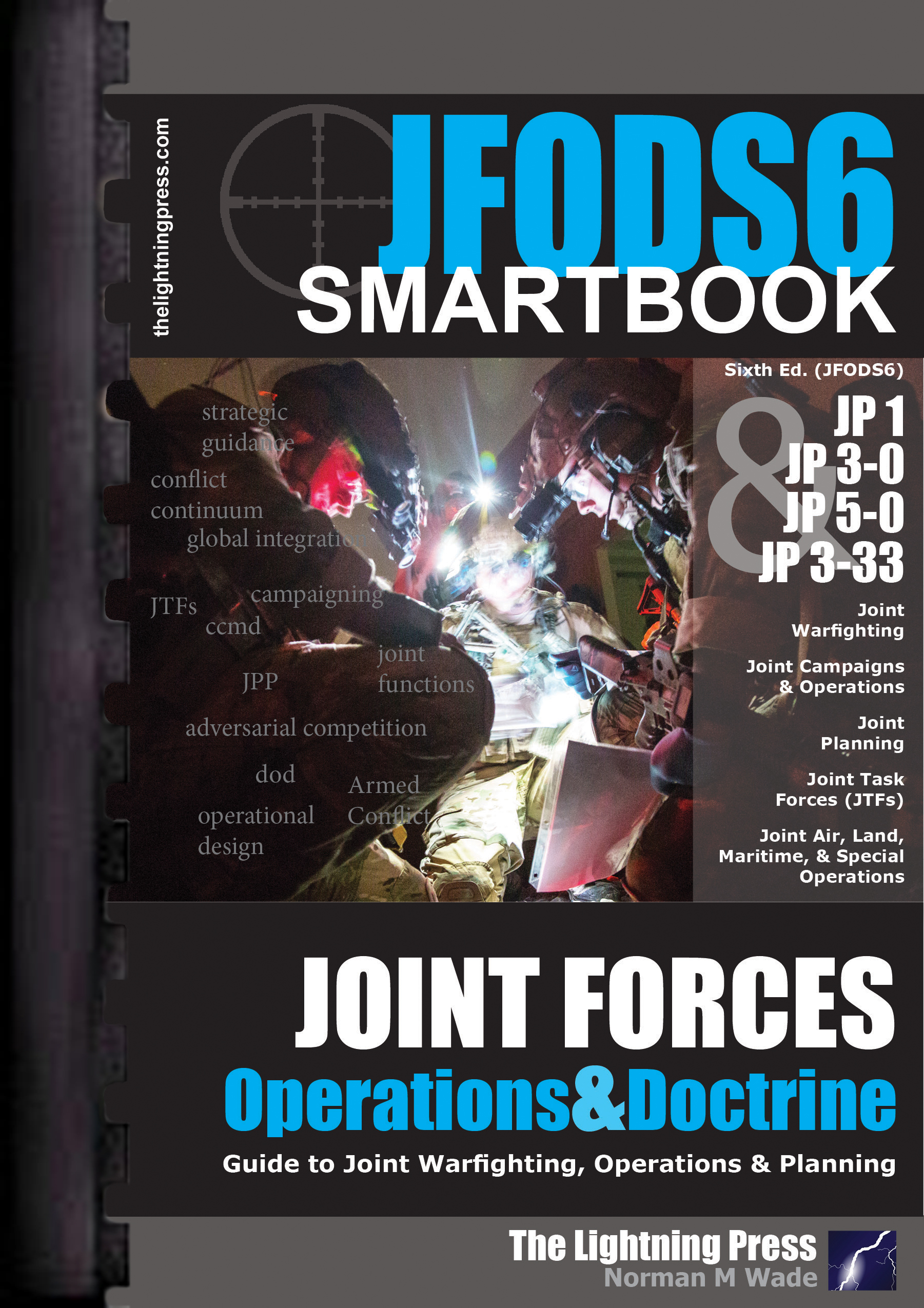

Paperback Edition
Price: $42.95 $36.95

Bundle & Save (Paperback + Digital)
Price: $85.90 $49.95
Guide to Joint Warfighting, Operations & Planning
JFODS6 is the sixth revised edition of The Joint Forces Operations & Doctrine SMARTbook. JFODS6 is completely updated for 2023 with new/updated material from the latest editions of JP 3-0 Joint Campaigns and Operations (Jun ‘22), JP 5-0 Joint Planning (Dec ‘20), JP 3-33 Joint Force Headquarters (Jun ‘22), and JP 1 Volumes I and II Joint Warfighting and the Joint Force (Jun ‘20), Additional topics and references include Joint Air, Land, Maritime and Special Operations (JPs 3-30, 3-31, 3-32 & 3-05).
The ultimate purpose of the Armed Forces of the United States is to defend the homeland and win the nation’s wars. The four strategic uses of the military instrument of national power - assurance; both forms of coercion, deterrence and compellence; and forcible action - are implemented through campaigns, operations, and activities that vary in purpose, scale, risk, and intensity, and occur across a competition continuum.
The competition continuum describes a world of enduring competition conducted through a mixture of cooperation, competition, and armed conflict. Competition is a fundamental aspect of international relations; as state and non-state actors seek to protect and advance their interests in pursuit of influence, advantage, and leverage, they continually compete over incompatible aims. Armed conflict occurs when a state or non-state actor uses lethal force as the primary means to satisfy its interests. Armed conflict varies in intensity and ranges from crisis response and limited contingency operations to large-scale combat operations.
The capability of the Armed Forces of the United States to operate as a cohesive joint force is a key advantage in any operational environment. Integrating Service components’ forces under a single joint force commander (JFC) maximizes the effectiveness and efficiency of the joint force. The joint force conducts campaigns and operations in a complex, volatile, security environment characterized by contested norms and persistent disorder. National security threats are transregional, all-domain, and multifunctional.
Joint planning is the deliberate process of determining how (the ways) to use military capabilities (the means) in time and space to achieve objectives (the ends) while considering the associated risks. Joint planning ties the military instrument of national power to the achievement of national security objectives and transforms national strategic objectives into operational design/approaches, lines of operation, and operational objectives, which in turn are carried out through tactical actions.
A joint task force (JTF) is the most common command and control option for conducting joint operations. A JTF may be established when the scope, complexity, or other factors of the operation require capabilities of Services from at least two MILDEPs operating under a single JFC. Commanders must integrate the capabilities and synchronize the operations of air, land, maritime, space, special operations, and cyberspace forces to defeat peer enemies.
Related Books
Discount sets with this book
OPFOR SMARTbook 4 - Iran & the Middle East
ISBN-10 :1-935886-92-4
Release Date :Jun 12th, 2023
Norman M. Wade
Binding Type:Perfect Bind
Print Inside Pages:Black and White
Trim Size:5.5'' x 8.5''
Total Pages:290
UPGRADE / CONVERT this book to premium GBC Plastic-Comb binding!
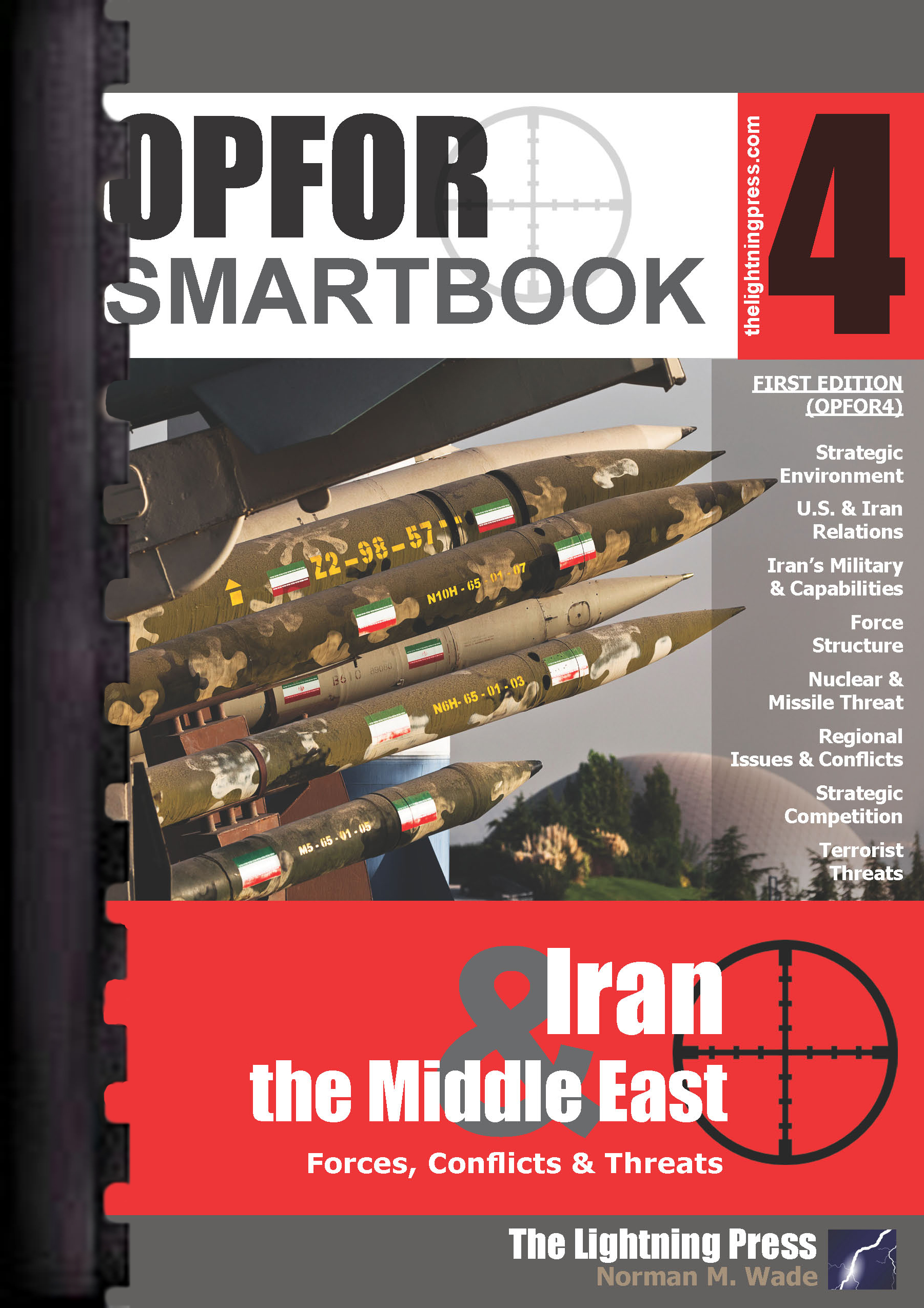

Paperback Edition
Price: $42.95 $36.95

Bundle & Save (Paperback + Digital)
Price: $85.90 $49.95
Forces, Conflicts & Threats
OPFOR4 topics and chapters include the strategic environment, U.S. & Iran relations (Iran’s foreign and defence policies, conflicts and tensions, sanctions), Iran’s military (history, doctrine and strategy, core capabilities), force structure, nuclear and missile threat, regional issues and conflicts (Iran’s partners and proxies, instruments of national security strategy), strategic competition (China, Russia, and others), and terrorist threats (VSEOs, Iran’s support for terrorism, etc.)
Spanning more than 4.6 million square miles, the Middle East has for millennia been a geographic and geopolitical crossroads and site of cooperation, competition, and conflict. Rich in cultural heritage but with unevenly distributed natural resources, the region is also beset by internal conflict and instability. More than a third of global container traffic transits the Suez Canal and more than a quarter of global oil transits the Strait of Hormuz. The region is home to almost 50% of the world’s known oil reserves and more than 40% of the world’s national gas.
The greatest single day-to-day threat to regional security and stability remains Iran, which challenges the U.S. and its allies by pursuing regional hegemony, breaching its JCPOA commitments, and posing a conventional threat to partner nations while facilitating and conducting coercive and malign activities.
To achieve its goals, Iran continues to rely on its unconventional warfare elements and asymmetric capabilities—intended to exploit the perceived weaknesses of a superior adversary—to provide deterrence and project power. This combination of lethal conventional capabilities and proxy forces poses a persistent threat. The Islamic Revolutionary Guard Corps Qods Force leads Iranian power projection through a complex network of state and nonstate partners and militant proxies.
Iran will continue to use Syrian (and likely Iraqi) territory as a critical hub and resupply route for maintaining its campaign against Israel. Iran will also remain focused on supporting Lebanese Hezbollah, whose illegal weapons stockpiles exceed those of most legitimate partner militaries in the region. The least restrained and most destabilizing of all of Iran’s affiliates in the region are the Houthis of Yemen. Aside from being active combatants in that country’s seven-year-old civil war, they are also engaged in a near-daily long-range fires conflict with Saudi Arabia.
While Iran poses the most ominous threat to the central region, Violent Extremist Organizations (VEOs) operating in the Middle East, Levant, and Central Asian States also represent a danger to security and stability. The Central Command area of responsibility serves as the epicenter of violent extremism, with 19 of 21 top tier terrorist groups operating across the region. ISIS and Al Qaeda are the principal Sunni violent extremist organizations in the Middle East and Levant. Both groups maintain numerous affiliates pursuing local, regional, and global objectives.
Related Books
Discount sets with this book
TLS7: The Leader’s SMARTbook, 7th Ed.
ISBN-10 :1-935886-95-9
Release Date :Aug 1st, 2023
Norman M. Wade
Binding Type:Plastic Comb
Print Inside Pages:Black and White
Trim Size:5.5'' x 8.5''
Total Pages:328

Paperback Edition
Price: $42.95 $36.95

Bundle & Save (Paperback + Digital)
Price: $85.90 $49.95
Leadership as a Dynamic of Combat Power
TLS7 is the seventh edition of The Leader’s SMARTbook, completely updated for 2023. TLS7 focuses on gaining the human advantage and leadership as a dynamic of combat power (FM 3-0, 2022), developing leaders, and training, the most important thing the Army does to prepare for operations. Topics and chapters include Army leadership and the profession (ADP 7-0); developing leaders (FM 6-22); counseling, coaching, and mentoring (ATP 6-22.1); Army team building (ATP 6-22.6); training to fight and win (ADP 7-0 / FM 7-0 / FM 7-22); planning & preparation: training guidance, meetings, schedules, briefs; executing training events and exercises, holistic health & fitness (H2F); training evaluations, assessments, and after action reviews.
Combat power is the total means of destructive and disruptive force that a military unit/formation can apply against an enemy at a given time. It is the ability to fight.
Leadership is the most essential dynamic of combat power. Leadership is the activity of influencing people by providing purpose, direction, and motivation to accomplish the mission and improve the organization.
The human dimension encompasses people and the interaction between individuals and groups, how they understand information and events, make decisions, generate will, and act within an operational environment. A human advantage occurs when a force holds the initiative in terms of training, morale, perception, and will.
Today’s Army demands trained and ready units with agile, proficient leaders. Army leaders are the competitive advantage the Army possesses that neither technology nor advanced weaponry and platforms can replace. Developing leaders is a complex and complicated undertaking because it is primarily a human endeavor—requiring constant involvement, assessment, and refinement.
The Army relies on effective teams to perform tasks, achieve objectives, and accomplish missions. Building and maintaining teams that operate effectively is essential. Team building is a continuous process of enabling a group of people to reach their goals and improve their effectiveness through leadership and various exercises, activities, and techniques.
The Army trains to fight and win—it is what we do in order to preserve the peace and to decisively defeat our enemies. We do this through challenging, relevant, and realistic training performed to the highest standards. The Army trains the way it operates. It does this by replicating in training how we expect to fight,closing the gap between operations and training.
To do this, the Army trains by developing proficiencies in mission-essential tasks, weapon systems, and the effective integration and employment of both. These components of training readiness provide the backbone to the development of unit readiness—the Army’s first priority.
Related Books
Discount sets with this book












